Comprehensive Marketing Strategy for Sensor Street Light Business
VerifiedAdded on 2023/04/07
|10
|1975
|274
Report
AI Summary
This report details a comprehensive marketing strategy for Sensor Street Light, focusing on increasing market share and achieving market leadership. It identifies key marketing objectives, including expanding coverage in South Australia and maintaining technological superiority. The target market is defined using demographic, geographic, psychographic, and behavioral segmentation variables. The proposed marketing strategies encompass positioning (smart lighting for smart people), product assortment, sales-oriented pricing, backward integration in distribution, and an omnichannel promotion approach, including digital and traditional media. The implementation process involves objective setting, stakeholder communication, budgeting, and continuous monitoring using key performance indicators like new customer inflow, retention rate, and revenue increase. The budget allocates funds for digital media, online marketing, and traditional newspaper advertising to maximize reach and impact.

Running head: MARKETING MANAGEMENT
Marketing management
Name of the student
Name of the university
Author note
Marketing management
Name of the student
Name of the university
Author note
Paraphrase This Document
Need a fresh take? Get an instant paraphrase of this document with our AI Paraphraser
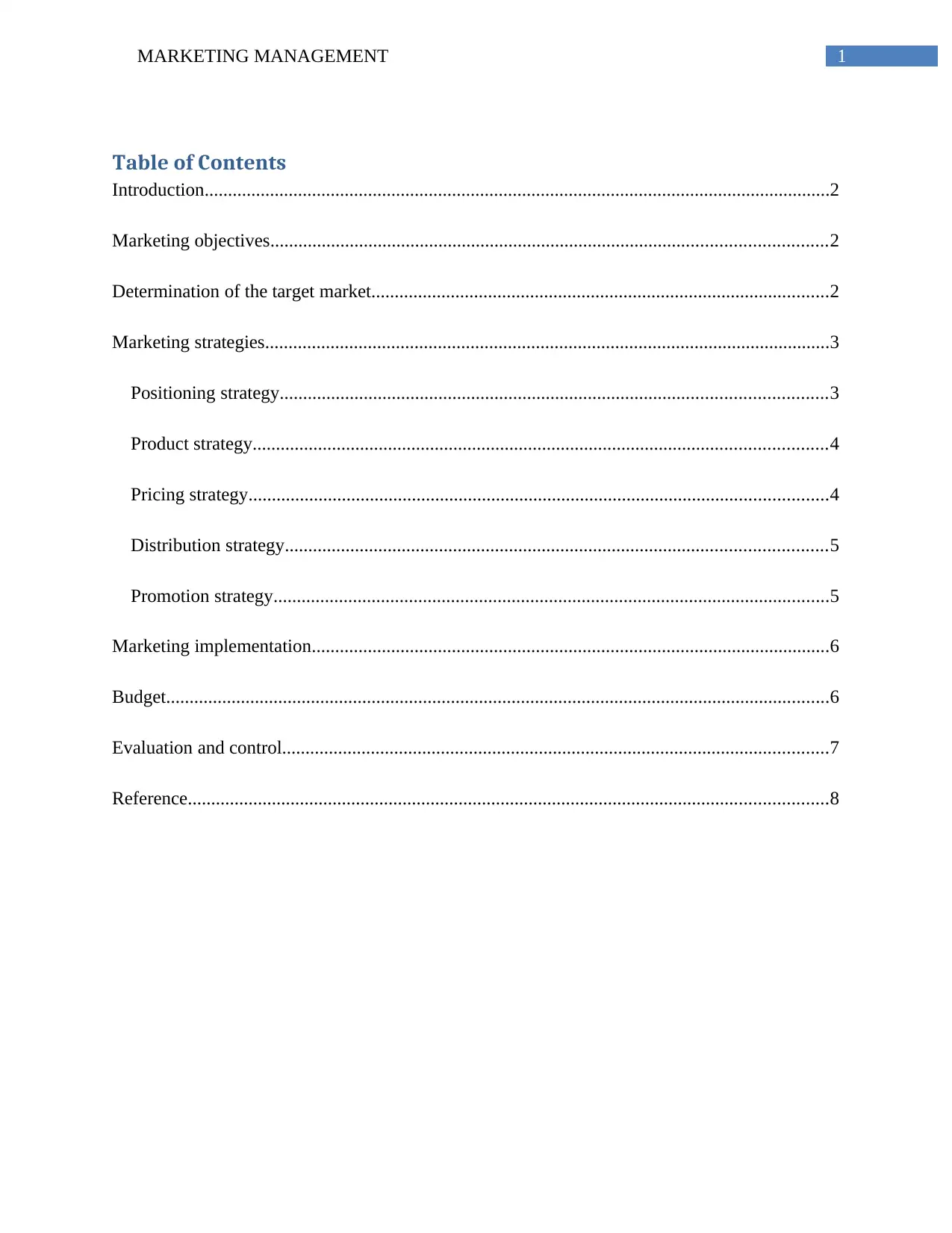
1MARKETING MANAGEMENT
Table of Contents
Introduction......................................................................................................................................2
Marketing objectives.......................................................................................................................2
Determination of the target market..................................................................................................2
Marketing strategies.........................................................................................................................3
Positioning strategy.....................................................................................................................3
Product strategy...........................................................................................................................4
Pricing strategy............................................................................................................................4
Distribution strategy....................................................................................................................5
Promotion strategy.......................................................................................................................5
Marketing implementation...............................................................................................................6
Budget..............................................................................................................................................6
Evaluation and control.....................................................................................................................7
Reference.........................................................................................................................................8
Table of Contents
Introduction......................................................................................................................................2
Marketing objectives.......................................................................................................................2
Determination of the target market..................................................................................................2
Marketing strategies.........................................................................................................................3
Positioning strategy.....................................................................................................................3
Product strategy...........................................................................................................................4
Pricing strategy............................................................................................................................4
Distribution strategy....................................................................................................................5
Promotion strategy.......................................................................................................................5
Marketing implementation...............................................................................................................6
Budget..............................................................................................................................................6
Evaluation and control.....................................................................................................................7
Reference.........................................................................................................................................8
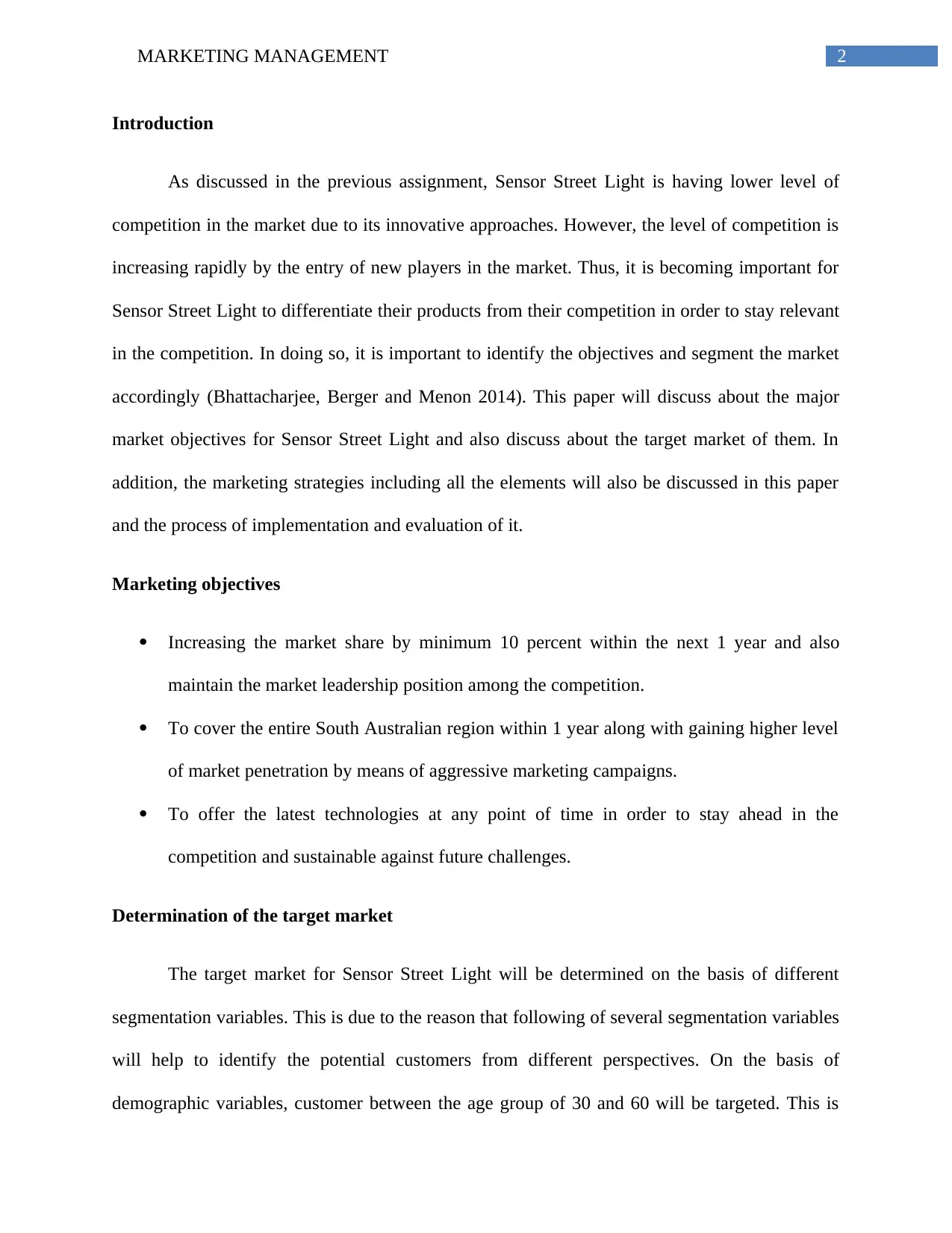
2MARKETING MANAGEMENT
Introduction
As discussed in the previous assignment, Sensor Street Light is having lower level of
competition in the market due to its innovative approaches. However, the level of competition is
increasing rapidly by the entry of new players in the market. Thus, it is becoming important for
Sensor Street Light to differentiate their products from their competition in order to stay relevant
in the competition. In doing so, it is important to identify the objectives and segment the market
accordingly (Bhattacharjee, Berger and Menon 2014). This paper will discuss about the major
market objectives for Sensor Street Light and also discuss about the target market of them. In
addition, the marketing strategies including all the elements will also be discussed in this paper
and the process of implementation and evaluation of it.
Marketing objectives
Increasing the market share by minimum 10 percent within the next 1 year and also
maintain the market leadership position among the competition.
To cover the entire South Australian region within 1 year along with gaining higher level
of market penetration by means of aggressive marketing campaigns.
To offer the latest technologies at any point of time in order to stay ahead in the
competition and sustainable against future challenges.
Determination of the target market
The target market for Sensor Street Light will be determined on the basis of different
segmentation variables. This is due to the reason that following of several segmentation variables
will help to identify the potential customers from different perspectives. On the basis of
demographic variables, customer between the age group of 30 and 60 will be targeted. This is
Introduction
As discussed in the previous assignment, Sensor Street Light is having lower level of
competition in the market due to its innovative approaches. However, the level of competition is
increasing rapidly by the entry of new players in the market. Thus, it is becoming important for
Sensor Street Light to differentiate their products from their competition in order to stay relevant
in the competition. In doing so, it is important to identify the objectives and segment the market
accordingly (Bhattacharjee, Berger and Menon 2014). This paper will discuss about the major
market objectives for Sensor Street Light and also discuss about the target market of them. In
addition, the marketing strategies including all the elements will also be discussed in this paper
and the process of implementation and evaluation of it.
Marketing objectives
Increasing the market share by minimum 10 percent within the next 1 year and also
maintain the market leadership position among the competition.
To cover the entire South Australian region within 1 year along with gaining higher level
of market penetration by means of aggressive marketing campaigns.
To offer the latest technologies at any point of time in order to stay ahead in the
competition and sustainable against future challenges.
Determination of the target market
The target market for Sensor Street Light will be determined on the basis of different
segmentation variables. This is due to the reason that following of several segmentation variables
will help to identify the potential customers from different perspectives. On the basis of
demographic variables, customer between the age group of 30 and 60 will be targeted. This is
⊘ This is a preview!⊘
Do you want full access?
Subscribe today to unlock all pages.

Trusted by 1+ million students worldwide
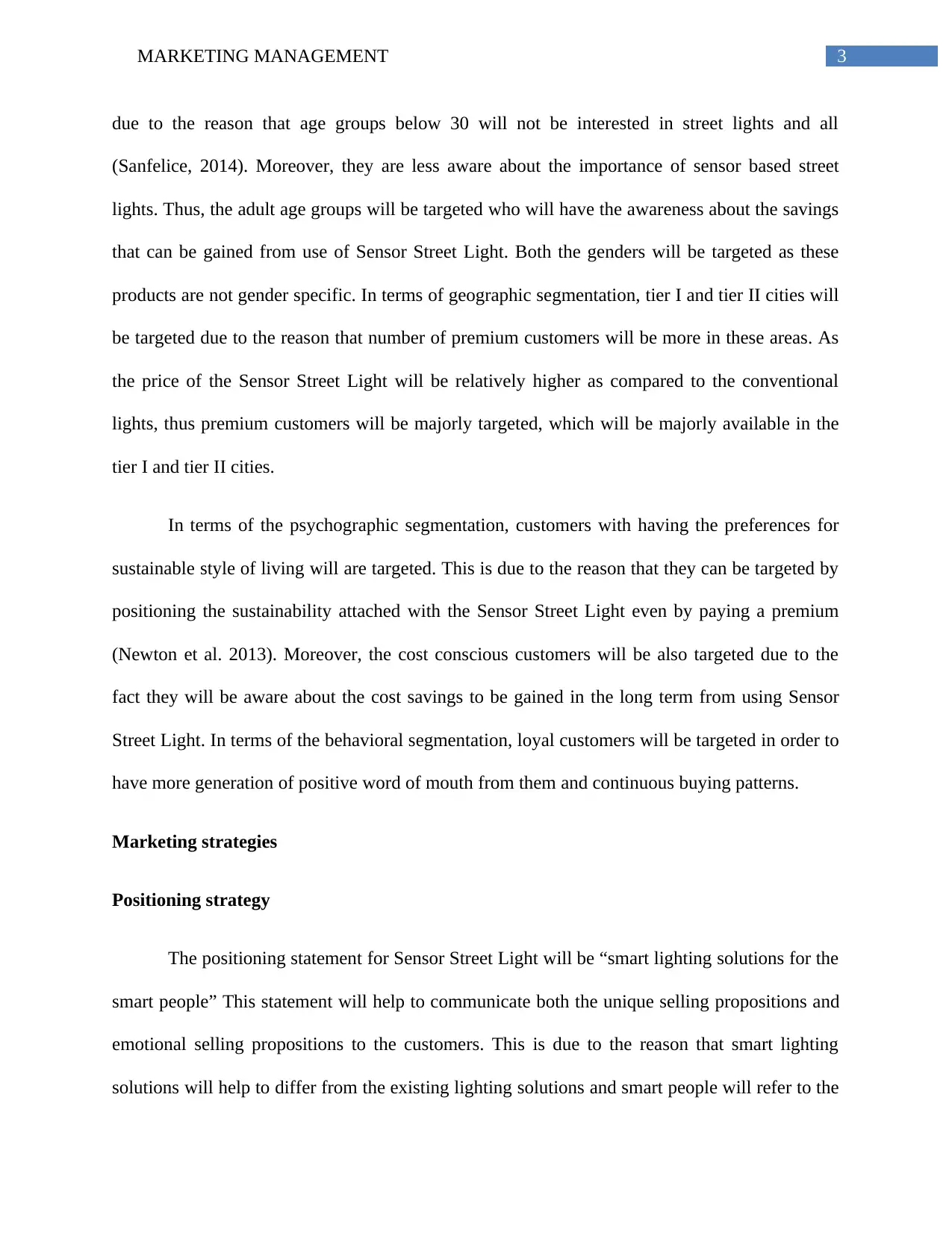
3MARKETING MANAGEMENT
due to the reason that age groups below 30 will not be interested in street lights and all
(Sanfelice, 2014). Moreover, they are less aware about the importance of sensor based street
lights. Thus, the adult age groups will be targeted who will have the awareness about the savings
that can be gained from use of Sensor Street Light. Both the genders will be targeted as these
products are not gender specific. In terms of geographic segmentation, tier I and tier II cities will
be targeted due to the reason that number of premium customers will be more in these areas. As
the price of the Sensor Street Light will be relatively higher as compared to the conventional
lights, thus premium customers will be majorly targeted, which will be majorly available in the
tier I and tier II cities.
In terms of the psychographic segmentation, customers with having the preferences for
sustainable style of living will are targeted. This is due to the reason that they can be targeted by
positioning the sustainability attached with the Sensor Street Light even by paying a premium
(Newton et al. 2013). Moreover, the cost conscious customers will be also targeted due to the
fact they will be aware about the cost savings to be gained in the long term from using Sensor
Street Light. In terms of the behavioral segmentation, loyal customers will be targeted in order to
have more generation of positive word of mouth from them and continuous buying patterns.
Marketing strategies
Positioning strategy
The positioning statement for Sensor Street Light will be “smart lighting solutions for the
smart people” This statement will help to communicate both the unique selling propositions and
emotional selling propositions to the customers. This is due to the reason that smart lighting
solutions will help to differ from the existing lighting solutions and smart people will refer to the
due to the reason that age groups below 30 will not be interested in street lights and all
(Sanfelice, 2014). Moreover, they are less aware about the importance of sensor based street
lights. Thus, the adult age groups will be targeted who will have the awareness about the savings
that can be gained from use of Sensor Street Light. Both the genders will be targeted as these
products are not gender specific. In terms of geographic segmentation, tier I and tier II cities will
be targeted due to the reason that number of premium customers will be more in these areas. As
the price of the Sensor Street Light will be relatively higher as compared to the conventional
lights, thus premium customers will be majorly targeted, which will be majorly available in the
tier I and tier II cities.
In terms of the psychographic segmentation, customers with having the preferences for
sustainable style of living will are targeted. This is due to the reason that they can be targeted by
positioning the sustainability attached with the Sensor Street Light even by paying a premium
(Newton et al. 2013). Moreover, the cost conscious customers will be also targeted due to the
fact they will be aware about the cost savings to be gained in the long term from using Sensor
Street Light. In terms of the behavioral segmentation, loyal customers will be targeted in order to
have more generation of positive word of mouth from them and continuous buying patterns.
Marketing strategies
Positioning strategy
The positioning statement for Sensor Street Light will be “smart lighting solutions for the
smart people” This statement will help to communicate both the unique selling propositions and
emotional selling propositions to the customers. This is due to the reason that smart lighting
solutions will help to differ from the existing lighting solutions and smart people will refer to the
Paraphrase This Document
Need a fresh take? Get an instant paraphrase of this document with our AI Paraphraser
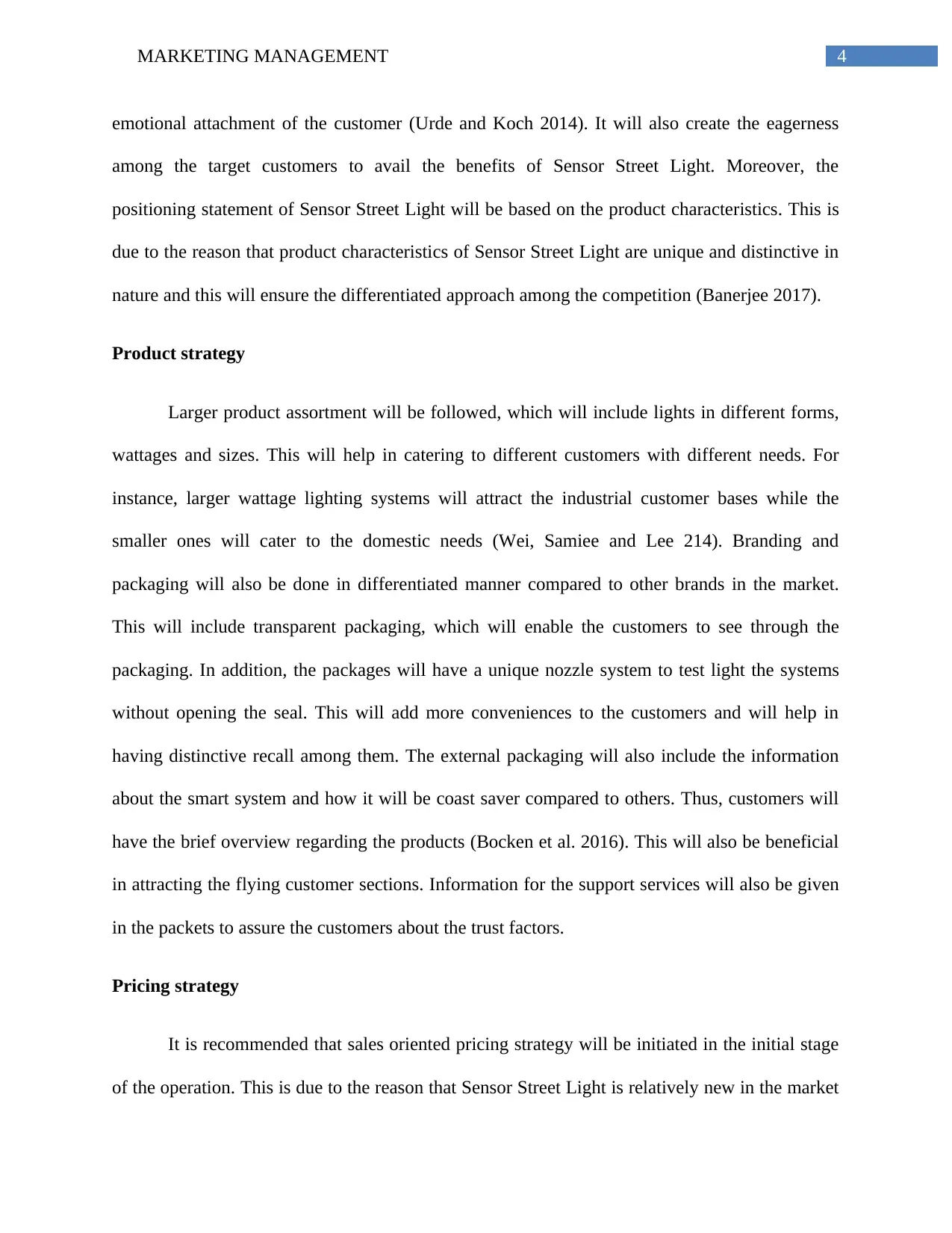
4MARKETING MANAGEMENT
emotional attachment of the customer (Urde and Koch 2014). It will also create the eagerness
among the target customers to avail the benefits of Sensor Street Light. Moreover, the
positioning statement of Sensor Street Light will be based on the product characteristics. This is
due to the reason that product characteristics of Sensor Street Light are unique and distinctive in
nature and this will ensure the differentiated approach among the competition (Banerjee 2017).
Product strategy
Larger product assortment will be followed, which will include lights in different forms,
wattages and sizes. This will help in catering to different customers with different needs. For
instance, larger wattage lighting systems will attract the industrial customer bases while the
smaller ones will cater to the domestic needs (Wei, Samiee and Lee 214). Branding and
packaging will also be done in differentiated manner compared to other brands in the market.
This will include transparent packaging, which will enable the customers to see through the
packaging. In addition, the packages will have a unique nozzle system to test light the systems
without opening the seal. This will add more conveniences to the customers and will help in
having distinctive recall among them. The external packaging will also include the information
about the smart system and how it will be coast saver compared to others. Thus, customers will
have the brief overview regarding the products (Bocken et al. 2016). This will also be beneficial
in attracting the flying customer sections. Information for the support services will also be given
in the packets to assure the customers about the trust factors.
Pricing strategy
It is recommended that sales oriented pricing strategy will be initiated in the initial stage
of the operation. This is due to the reason that Sensor Street Light is relatively new in the market
emotional attachment of the customer (Urde and Koch 2014). It will also create the eagerness
among the target customers to avail the benefits of Sensor Street Light. Moreover, the
positioning statement of Sensor Street Light will be based on the product characteristics. This is
due to the reason that product characteristics of Sensor Street Light are unique and distinctive in
nature and this will ensure the differentiated approach among the competition (Banerjee 2017).
Product strategy
Larger product assortment will be followed, which will include lights in different forms,
wattages and sizes. This will help in catering to different customers with different needs. For
instance, larger wattage lighting systems will attract the industrial customer bases while the
smaller ones will cater to the domestic needs (Wei, Samiee and Lee 214). Branding and
packaging will also be done in differentiated manner compared to other brands in the market.
This will include transparent packaging, which will enable the customers to see through the
packaging. In addition, the packages will have a unique nozzle system to test light the systems
without opening the seal. This will add more conveniences to the customers and will help in
having distinctive recall among them. The external packaging will also include the information
about the smart system and how it will be coast saver compared to others. Thus, customers will
have the brief overview regarding the products (Bocken et al. 2016). This will also be beneficial
in attracting the flying customer sections. Information for the support services will also be given
in the packets to assure the customers about the trust factors.
Pricing strategy
It is recommended that sales oriented pricing strategy will be initiated in the initial stage
of the operation. This is due to the reason that Sensor Street Light is relatively new in the market
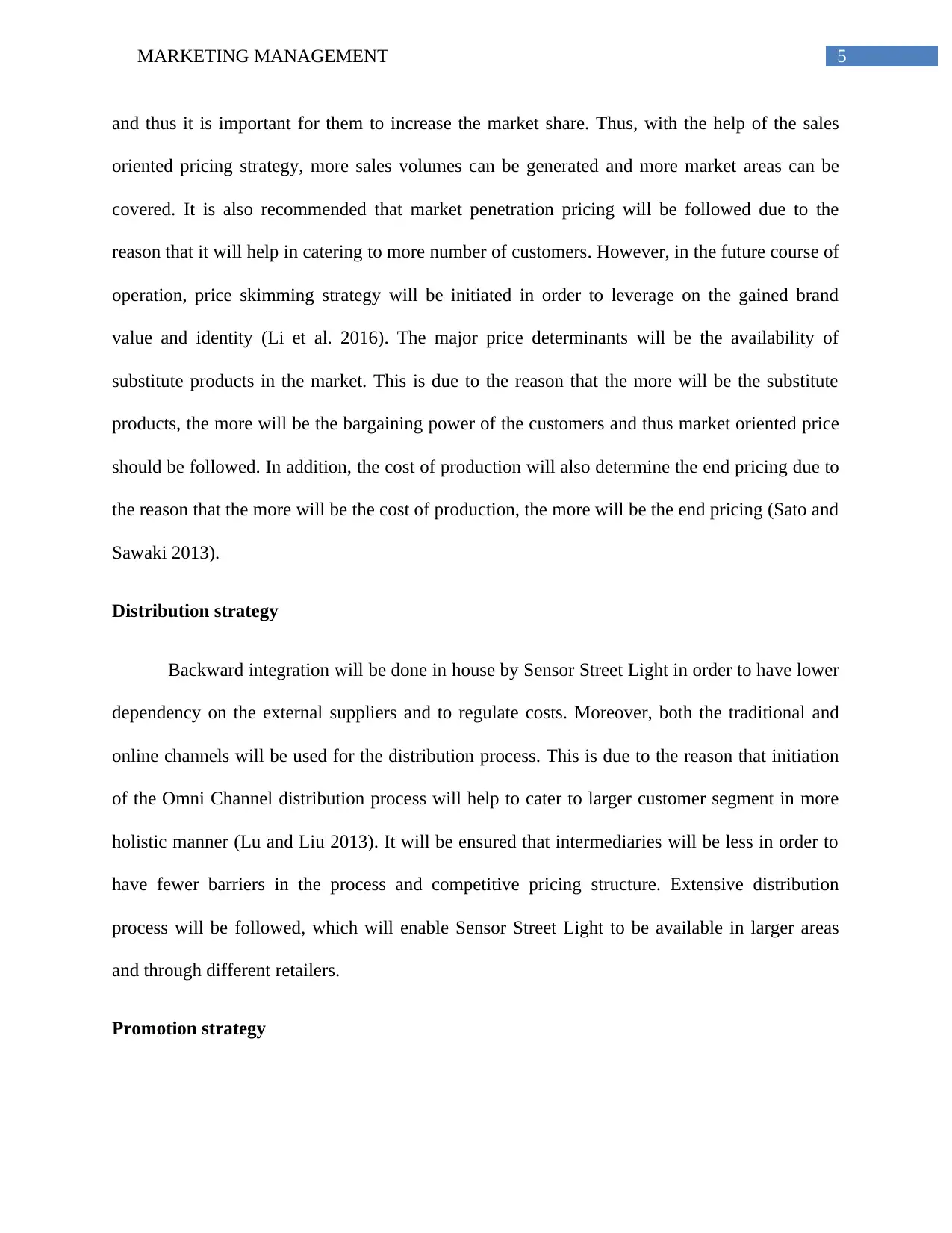
5MARKETING MANAGEMENT
and thus it is important for them to increase the market share. Thus, with the help of the sales
oriented pricing strategy, more sales volumes can be generated and more market areas can be
covered. It is also recommended that market penetration pricing will be followed due to the
reason that it will help in catering to more number of customers. However, in the future course of
operation, price skimming strategy will be initiated in order to leverage on the gained brand
value and identity (Li et al. 2016). The major price determinants will be the availability of
substitute products in the market. This is due to the reason that the more will be the substitute
products, the more will be the bargaining power of the customers and thus market oriented price
should be followed. In addition, the cost of production will also determine the end pricing due to
the reason that the more will be the cost of production, the more will be the end pricing (Sato and
Sawaki 2013).
Distribution strategy
Backward integration will be done in house by Sensor Street Light in order to have lower
dependency on the external suppliers and to regulate costs. Moreover, both the traditional and
online channels will be used for the distribution process. This is due to the reason that initiation
of the Omni Channel distribution process will help to cater to larger customer segment in more
holistic manner (Lu and Liu 2013). It will be ensured that intermediaries will be less in order to
have fewer barriers in the process and competitive pricing structure. Extensive distribution
process will be followed, which will enable Sensor Street Light to be available in larger areas
and through different retailers.
Promotion strategy
and thus it is important for them to increase the market share. Thus, with the help of the sales
oriented pricing strategy, more sales volumes can be generated and more market areas can be
covered. It is also recommended that market penetration pricing will be followed due to the
reason that it will help in catering to more number of customers. However, in the future course of
operation, price skimming strategy will be initiated in order to leverage on the gained brand
value and identity (Li et al. 2016). The major price determinants will be the availability of
substitute products in the market. This is due to the reason that the more will be the substitute
products, the more will be the bargaining power of the customers and thus market oriented price
should be followed. In addition, the cost of production will also determine the end pricing due to
the reason that the more will be the cost of production, the more will be the end pricing (Sato and
Sawaki 2013).
Distribution strategy
Backward integration will be done in house by Sensor Street Light in order to have lower
dependency on the external suppliers and to regulate costs. Moreover, both the traditional and
online channels will be used for the distribution process. This is due to the reason that initiation
of the Omni Channel distribution process will help to cater to larger customer segment in more
holistic manner (Lu and Liu 2013). It will be ensured that intermediaries will be less in order to
have fewer barriers in the process and competitive pricing structure. Extensive distribution
process will be followed, which will enable Sensor Street Light to be available in larger areas
and through different retailers.
Promotion strategy
⊘ This is a preview!⊘
Do you want full access?
Subscribe today to unlock all pages.

Trusted by 1+ million students worldwide
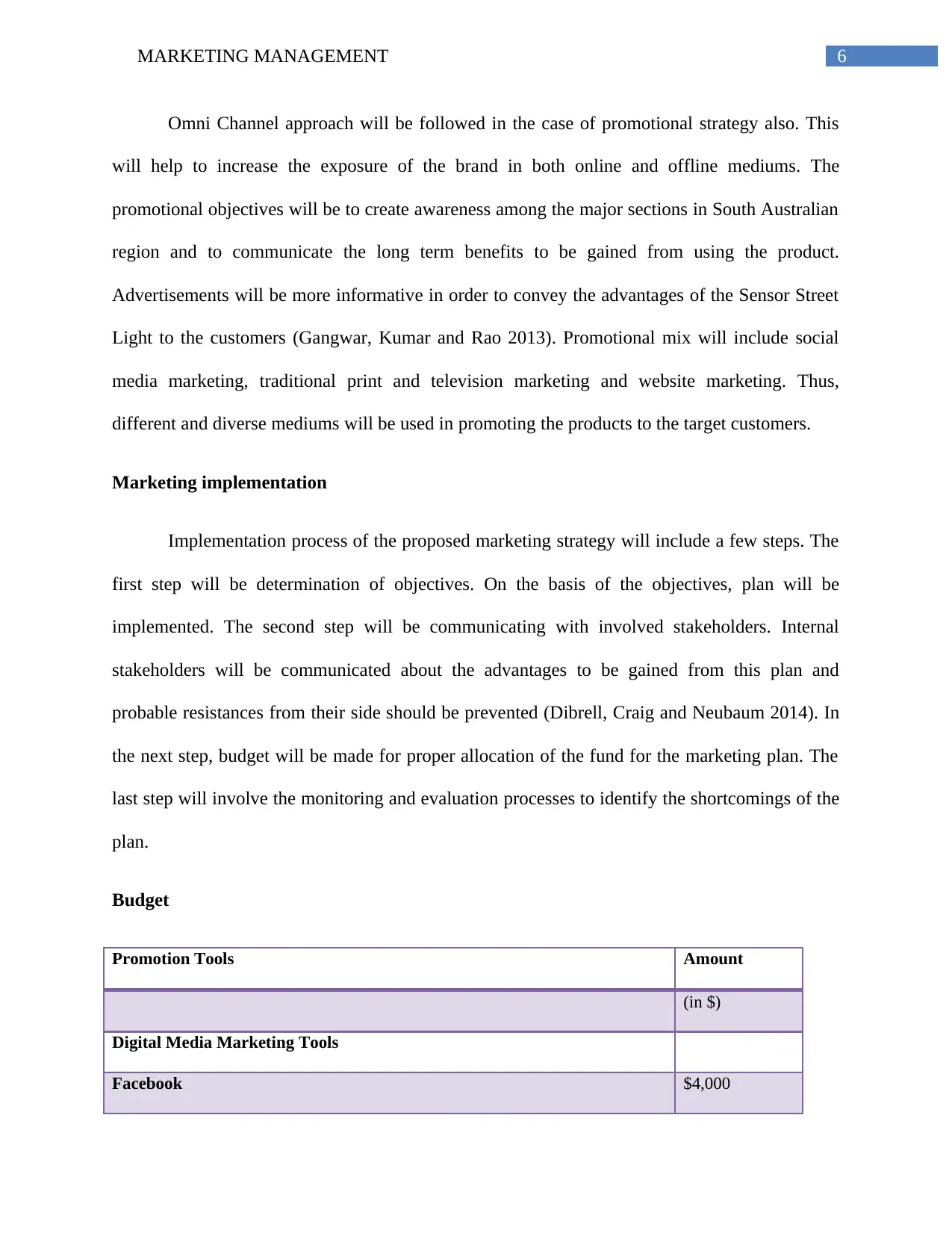
6MARKETING MANAGEMENT
Omni Channel approach will be followed in the case of promotional strategy also. This
will help to increase the exposure of the brand in both online and offline mediums. The
promotional objectives will be to create awareness among the major sections in South Australian
region and to communicate the long term benefits to be gained from using the product.
Advertisements will be more informative in order to convey the advantages of the Sensor Street
Light to the customers (Gangwar, Kumar and Rao 2013). Promotional mix will include social
media marketing, traditional print and television marketing and website marketing. Thus,
different and diverse mediums will be used in promoting the products to the target customers.
Marketing implementation
Implementation process of the proposed marketing strategy will include a few steps. The
first step will be determination of objectives. On the basis of the objectives, plan will be
implemented. The second step will be communicating with involved stakeholders. Internal
stakeholders will be communicated about the advantages to be gained from this plan and
probable resistances from their side should be prevented (Dibrell, Craig and Neubaum 2014). In
the next step, budget will be made for proper allocation of the fund for the marketing plan. The
last step will involve the monitoring and evaluation processes to identify the shortcomings of the
plan.
Budget
Promotion Tools Amount
(in $)
Digital Media Marketing Tools
Facebook $4,000
Omni Channel approach will be followed in the case of promotional strategy also. This
will help to increase the exposure of the brand in both online and offline mediums. The
promotional objectives will be to create awareness among the major sections in South Australian
region and to communicate the long term benefits to be gained from using the product.
Advertisements will be more informative in order to convey the advantages of the Sensor Street
Light to the customers (Gangwar, Kumar and Rao 2013). Promotional mix will include social
media marketing, traditional print and television marketing and website marketing. Thus,
different and diverse mediums will be used in promoting the products to the target customers.
Marketing implementation
Implementation process of the proposed marketing strategy will include a few steps. The
first step will be determination of objectives. On the basis of the objectives, plan will be
implemented. The second step will be communicating with involved stakeholders. Internal
stakeholders will be communicated about the advantages to be gained from this plan and
probable resistances from their side should be prevented (Dibrell, Craig and Neubaum 2014). In
the next step, budget will be made for proper allocation of the fund for the marketing plan. The
last step will involve the monitoring and evaluation processes to identify the shortcomings of the
plan.
Budget
Promotion Tools Amount
(in $)
Digital Media Marketing Tools
Facebook $4,000
Paraphrase This Document
Need a fresh take? Get an instant paraphrase of this document with our AI Paraphraser
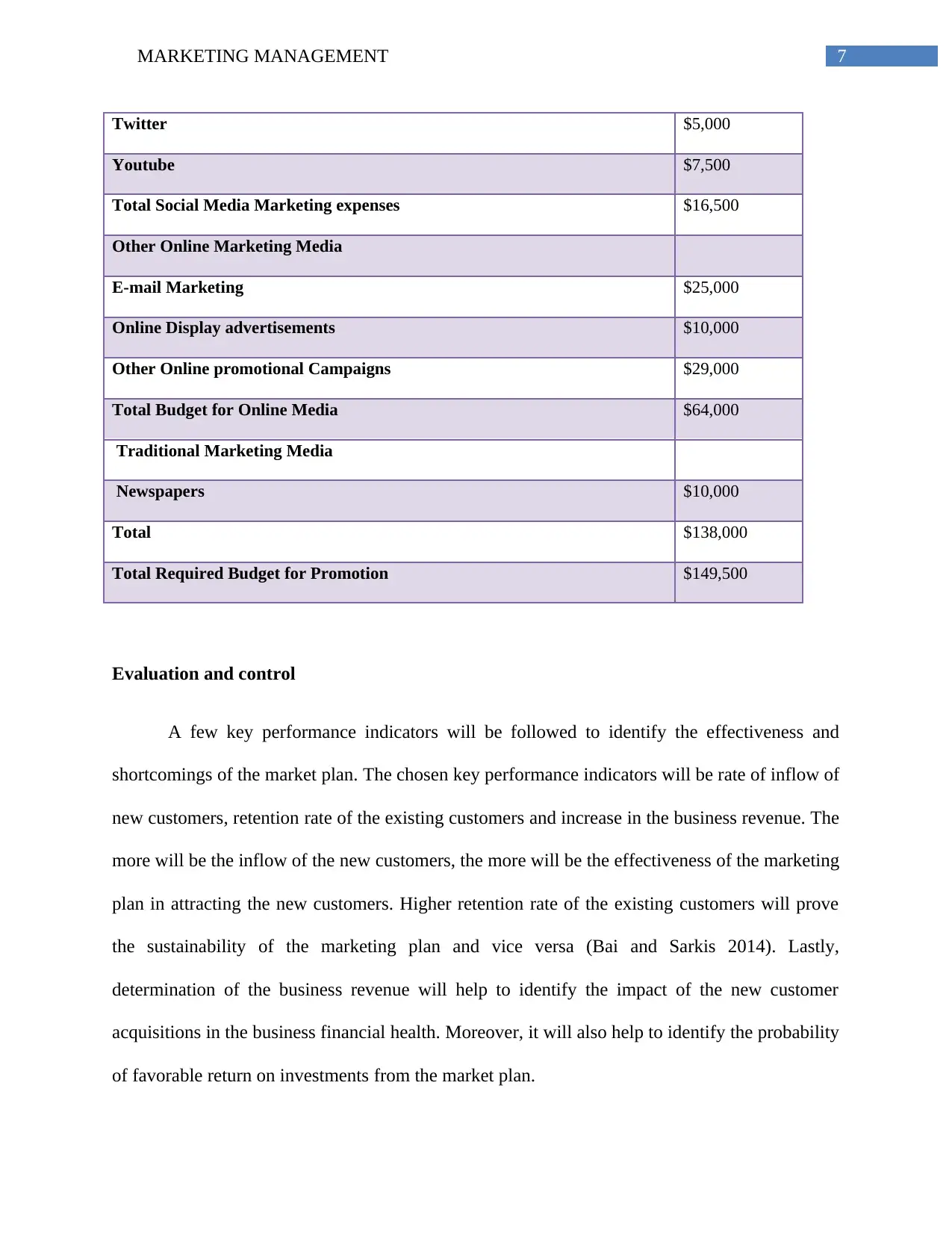
7MARKETING MANAGEMENT
Twitter $5,000
Youtube $7,500
Total Social Media Marketing expenses $16,500
Other Online Marketing Media
E-mail Marketing $25,000
Online Display advertisements $10,000
Other Online promotional Campaigns $29,000
Total Budget for Online Media $64,000
Traditional Marketing Media
Newspapers $10,000
Total $138,000
Total Required Budget for Promotion $149,500
Evaluation and control
A few key performance indicators will be followed to identify the effectiveness and
shortcomings of the market plan. The chosen key performance indicators will be rate of inflow of
new customers, retention rate of the existing customers and increase in the business revenue. The
more will be the inflow of the new customers, the more will be the effectiveness of the marketing
plan in attracting the new customers. Higher retention rate of the existing customers will prove
the sustainability of the marketing plan and vice versa (Bai and Sarkis 2014). Lastly,
determination of the business revenue will help to identify the impact of the new customer
acquisitions in the business financial health. Moreover, it will also help to identify the probability
of favorable return on investments from the market plan.
Twitter $5,000
Youtube $7,500
Total Social Media Marketing expenses $16,500
Other Online Marketing Media
E-mail Marketing $25,000
Online Display advertisements $10,000
Other Online promotional Campaigns $29,000
Total Budget for Online Media $64,000
Traditional Marketing Media
Newspapers $10,000
Total $138,000
Total Required Budget for Promotion $149,500
Evaluation and control
A few key performance indicators will be followed to identify the effectiveness and
shortcomings of the market plan. The chosen key performance indicators will be rate of inflow of
new customers, retention rate of the existing customers and increase in the business revenue. The
more will be the inflow of the new customers, the more will be the effectiveness of the marketing
plan in attracting the new customers. Higher retention rate of the existing customers will prove
the sustainability of the marketing plan and vice versa (Bai and Sarkis 2014). Lastly,
determination of the business revenue will help to identify the impact of the new customer
acquisitions in the business financial health. Moreover, it will also help to identify the probability
of favorable return on investments from the market plan.
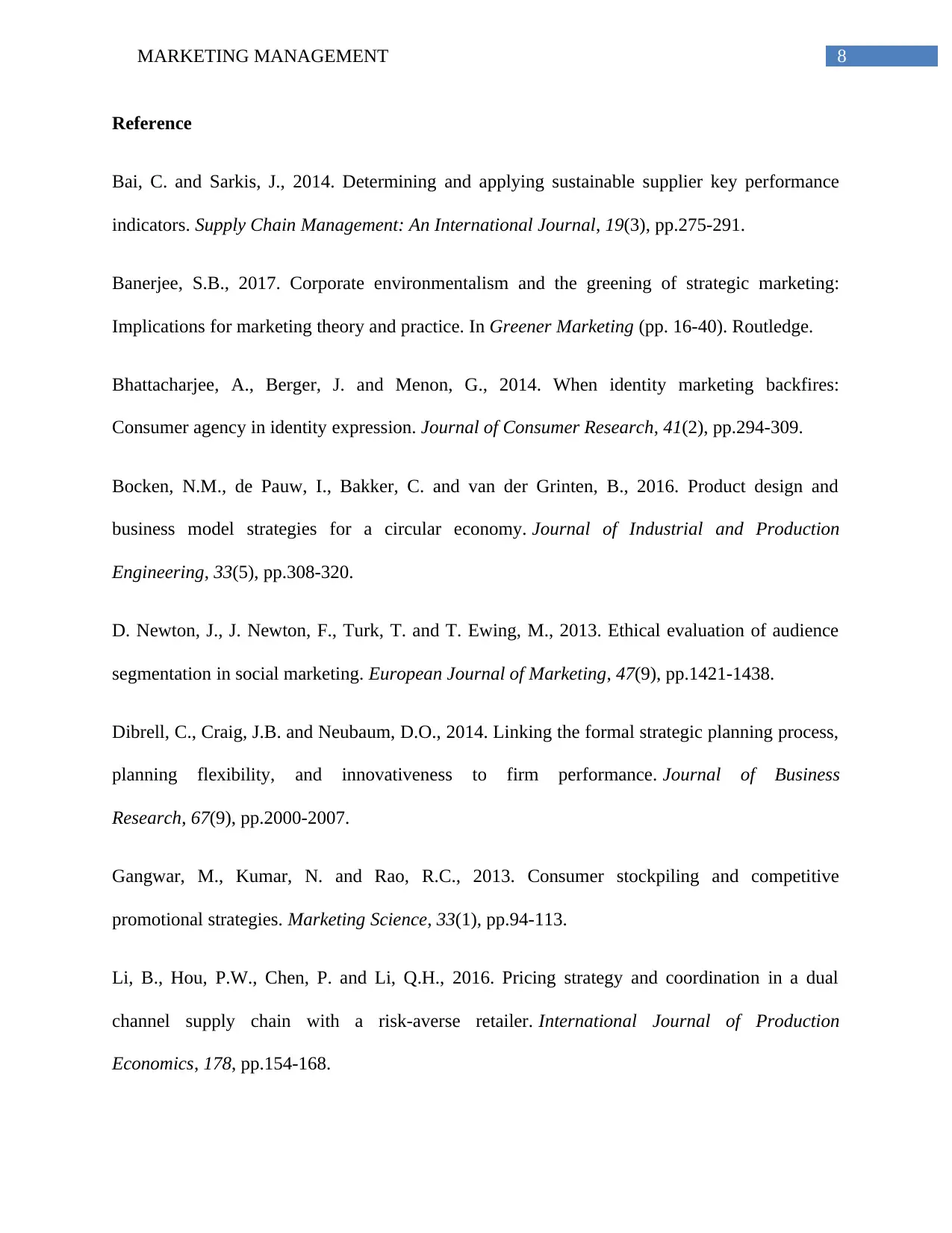
8MARKETING MANAGEMENT
Reference
Bai, C. and Sarkis, J., 2014. Determining and applying sustainable supplier key performance
indicators. Supply Chain Management: An International Journal, 19(3), pp.275-291.
Banerjee, S.B., 2017. Corporate environmentalism and the greening of strategic marketing:
Implications for marketing theory and practice. In Greener Marketing (pp. 16-40). Routledge.
Bhattacharjee, A., Berger, J. and Menon, G., 2014. When identity marketing backfires:
Consumer agency in identity expression. Journal of Consumer Research, 41(2), pp.294-309.
Bocken, N.M., de Pauw, I., Bakker, C. and van der Grinten, B., 2016. Product design and
business model strategies for a circular economy. Journal of Industrial and Production
Engineering, 33(5), pp.308-320.
D. Newton, J., J. Newton, F., Turk, T. and T. Ewing, M., 2013. Ethical evaluation of audience
segmentation in social marketing. European Journal of Marketing, 47(9), pp.1421-1438.
Dibrell, C., Craig, J.B. and Neubaum, D.O., 2014. Linking the formal strategic planning process,
planning flexibility, and innovativeness to firm performance. Journal of Business
Research, 67(9), pp.2000-2007.
Gangwar, M., Kumar, N. and Rao, R.C., 2013. Consumer stockpiling and competitive
promotional strategies. Marketing Science, 33(1), pp.94-113.
Li, B., Hou, P.W., Chen, P. and Li, Q.H., 2016. Pricing strategy and coordination in a dual
channel supply chain with a risk-averse retailer. International Journal of Production
Economics, 178, pp.154-168.
Reference
Bai, C. and Sarkis, J., 2014. Determining and applying sustainable supplier key performance
indicators. Supply Chain Management: An International Journal, 19(3), pp.275-291.
Banerjee, S.B., 2017. Corporate environmentalism and the greening of strategic marketing:
Implications for marketing theory and practice. In Greener Marketing (pp. 16-40). Routledge.
Bhattacharjee, A., Berger, J. and Menon, G., 2014. When identity marketing backfires:
Consumer agency in identity expression. Journal of Consumer Research, 41(2), pp.294-309.
Bocken, N.M., de Pauw, I., Bakker, C. and van der Grinten, B., 2016. Product design and
business model strategies for a circular economy. Journal of Industrial and Production
Engineering, 33(5), pp.308-320.
D. Newton, J., J. Newton, F., Turk, T. and T. Ewing, M., 2013. Ethical evaluation of audience
segmentation in social marketing. European Journal of Marketing, 47(9), pp.1421-1438.
Dibrell, C., Craig, J.B. and Neubaum, D.O., 2014. Linking the formal strategic planning process,
planning flexibility, and innovativeness to firm performance. Journal of Business
Research, 67(9), pp.2000-2007.
Gangwar, M., Kumar, N. and Rao, R.C., 2013. Consumer stockpiling and competitive
promotional strategies. Marketing Science, 33(1), pp.94-113.
Li, B., Hou, P.W., Chen, P. and Li, Q.H., 2016. Pricing strategy and coordination in a dual
channel supply chain with a risk-averse retailer. International Journal of Production
Economics, 178, pp.154-168.
⊘ This is a preview!⊘
Do you want full access?
Subscribe today to unlock all pages.

Trusted by 1+ million students worldwide
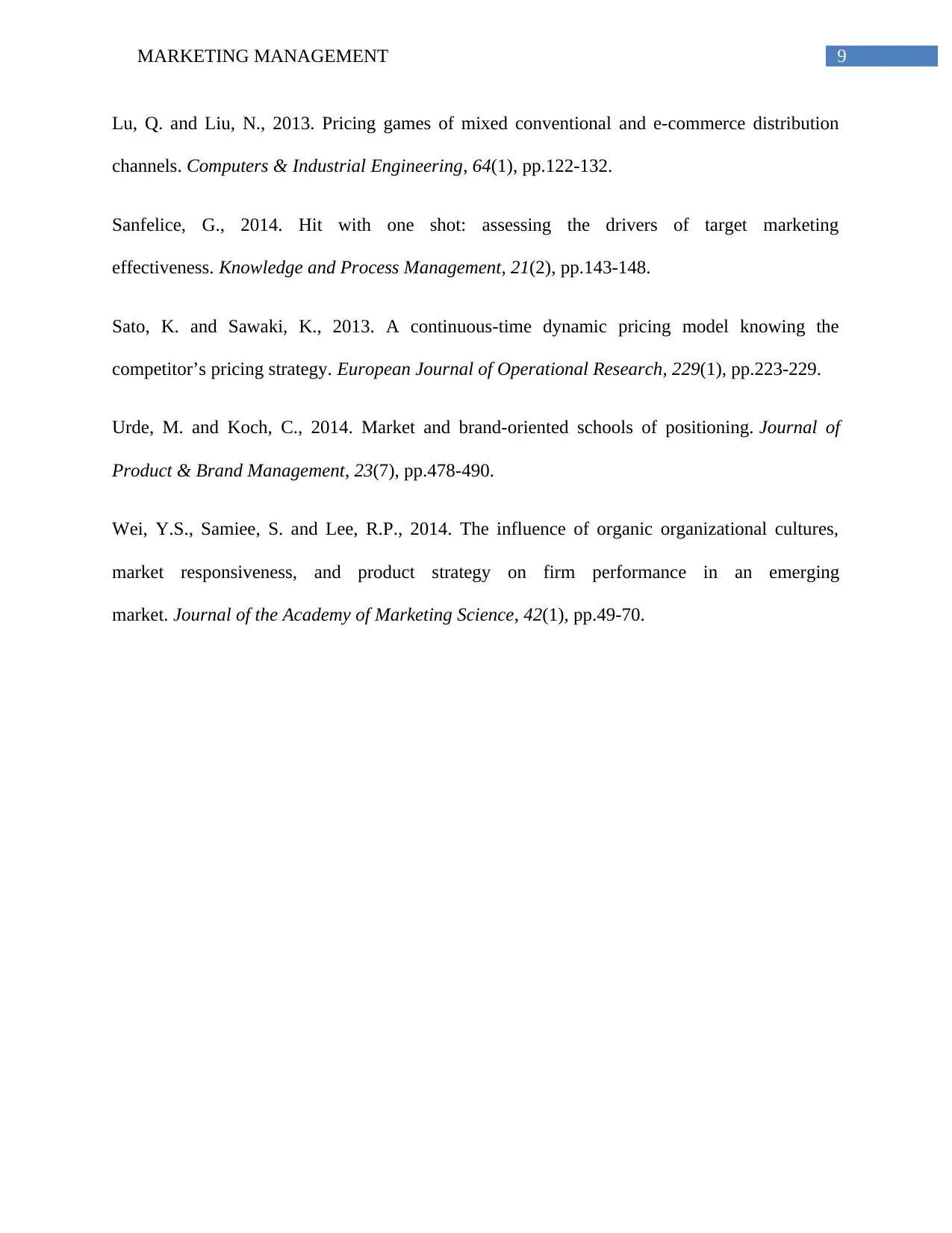
9MARKETING MANAGEMENT
Lu, Q. and Liu, N., 2013. Pricing games of mixed conventional and e-commerce distribution
channels. Computers & Industrial Engineering, 64(1), pp.122-132.
Sanfelice, G., 2014. Hit with one shot: assessing the drivers of target marketing
effectiveness. Knowledge and Process Management, 21(2), pp.143-148.
Sato, K. and Sawaki, K., 2013. A continuous-time dynamic pricing model knowing the
competitor’s pricing strategy. European Journal of Operational Research, 229(1), pp.223-229.
Urde, M. and Koch, C., 2014. Market and brand-oriented schools of positioning. Journal of
Product & Brand Management, 23(7), pp.478-490.
Wei, Y.S., Samiee, S. and Lee, R.P., 2014. The influence of organic organizational cultures,
market responsiveness, and product strategy on firm performance in an emerging
market. Journal of the Academy of Marketing Science, 42(1), pp.49-70.
Lu, Q. and Liu, N., 2013. Pricing games of mixed conventional and e-commerce distribution
channels. Computers & Industrial Engineering, 64(1), pp.122-132.
Sanfelice, G., 2014. Hit with one shot: assessing the drivers of target marketing
effectiveness. Knowledge and Process Management, 21(2), pp.143-148.
Sato, K. and Sawaki, K., 2013. A continuous-time dynamic pricing model knowing the
competitor’s pricing strategy. European Journal of Operational Research, 229(1), pp.223-229.
Urde, M. and Koch, C., 2014. Market and brand-oriented schools of positioning. Journal of
Product & Brand Management, 23(7), pp.478-490.
Wei, Y.S., Samiee, S. and Lee, R.P., 2014. The influence of organic organizational cultures,
market responsiveness, and product strategy on firm performance in an emerging
market. Journal of the Academy of Marketing Science, 42(1), pp.49-70.
1 out of 10
Related Documents
Your All-in-One AI-Powered Toolkit for Academic Success.
+13062052269
info@desklib.com
Available 24*7 on WhatsApp / Email
![[object Object]](/_next/static/media/star-bottom.7253800d.svg)
Unlock your academic potential
Copyright © 2020–2025 A2Z Services. All Rights Reserved. Developed and managed by ZUCOL.





